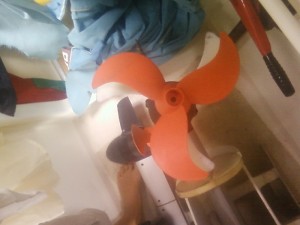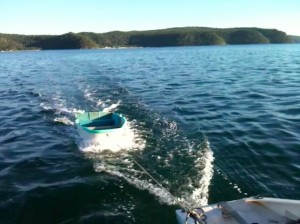This morning dawned clear and calm and it beckoned me to take a nice cruise out to the heads to compare the speed prop and the standard prop.

The standard prop is that safety orange colour that keeps popping up on Torqeedo motors and data sheets, and so on. I guess its their favourite colour. The speed prop is plain white so its easy to tell them apart.
Its not so obvious in this picture but you can probably pick up that the standard prop is finer and especially towards the tips of the blades. The white prop feels thicker as well – perhaps it needs to be because of the extra surface area. But I didn’t measure this – its just how it feels.

Here’s another photo with the props more or less aligned on their leading edges. The shape of the leading edge is curved differently, so it can’t be an exact alignment but its close enough for you to get the picture.
The pitch of the standard prop is ten inches, compared with the twelve inch pitch of the speed prop. This extra 20 % of pitch should mean an extra 20% in speed for a boat whose drag is nicely matched to the power of the motor.

On this test today there is more than usual drag because the bottom is beginning to get some growth and she’s towing a dinghy. It was from this dinghy that the errant 801 took its swan dive.
First part of the trial was out to Broken Bay heads on the white prop – and I had in mind to swap props when I got out there – but thought better of it and decided to return to the mooring and swap the prop in more controlled conditions. After fitting the standard prop I went out and repeated the readings again. The conditions were identical.
What it shows is that the only difference is top speed. Otherwise the props perform identically comparing speed and power. If there was a way of measuring revs we’d probably find that there’s a difference in rpm at a given speed. I think the limiting factor is the power of the motor, and the speed prop overpowers the motor on this boat.

Think of it as driving a car in too high a gear. The speed prop is like an overdrive gear – on a nice flat road under good conditions you can get a higher top speed in overdrive. But load the vehicle in any way, such as a hill or headwind, and its better to choose a lower gear to get the best speed.
I’ve been favouring the speed prop because it is better in reverse, and it seems that there’s no penalty in efficiency at any particular speed in choosing the speed prop.
When running at top speed with the standard prop it was absorbing 5100 watts and after about 5 minutes the controller automatically reduced this to 4600 watts when the motor began to get too hot. The thermometer symbol appeared on the throttle control and so I cut the power back down to about 2000 watts. After a minute or two the over-temperature signal disappeared.
It makes me wonder whether even the standard prop is still to high a gear? Running the calculations for prop slip shows that slip for the standard prop is around 60% and for the speed prop is around 100%. These are both much higher than expected, and so these theoretical factors also suggest both props are over pitched for this boat. I notice that the new model 1003 prop has a pitch of 8.1 inches – I think this is too fine for what I need but it would be interesting just to test it and see what happens. I wonder if it has the same hub?…

Hi Chris.
Sorry to hear that you won’t get your loss covered… Shit happens. However, you seem to spend most of your time on CurrentSunshine and living your dream. As long as the financial losses don’t stop you from cruising, I’d consider it a minor setback and if you can repair it then you had at least a positive experience from it…
Reading your speed trials with the two different props I remembered an email I once wrote to torqeedo in Germany (one of those they never answered).
One of the topics concerned propellers. Though I really know nothing about boat propulsion, I can read and remember some figures. Torqeedo claims on one page that their engine has an overall efficiency of 51%. On another page they explain why this same engine with 4 kW can be freely used without a boating license in Germany (you don’t need it for engines up to 5 hp (3,68 kW) at the shaft: The reason is that it only delivers 3,5 kW to the shaft.
Now comes the question. Is this 3,5 kW reached at 4 kW input power or at the 5+ kW the engine seems to be able to deliver for short periods of time? In the first case this would mean that only 12,5% of the losses are due to the drive train/gearing/controller and the residual 38,5% are due to propeller losses. This would not sound too impressive for a high efficiency prop though. As I pointed out I have no idea about hydrodynamics and maybe these values are really good… Though I wonder why I didn’t get any answer on my questions. The other possibility is that the shaft power was measured with it’s full power at 5+ kW which would shed a bad light on the efficiency of the drive train used (as far as I know the German testing authorities, I would expect the latter case to be true). Your measurements (and the use of the same props on engines between 400 and 4000 Watts) seem to indicate that the torqeedo props are not speed/load specific at all, especially since you don’t observe any difference between the higher pitched prop and the lower pitched prop at identical environmental conditions. Or does that mean that the propellers are efficient regardless of boat speed?
I still think these engines are good and meet the requirements of the average users they are intended for. They probably are also the most efficient outboard engines on the market to date, but I doubt they can compare with an inboard alternative (and torqeedo does not claim that either). There is also evidence for this on a Finnish blog. A boat owner and electric engine enthusiast did a comparison of his inboard electric engine with the old Torqeedo 2.0 on the same sailboat. Although the data is hampered by the boats own prop dragging throughout the experiment i think it gives a clue about the overall efficiency of the systems used (http://www.electricocean.fi/blog/).
That said for you an inboard engine is no option. Neither is it for me. This year I will try to sail more and use my gasoline outboard less and only at speeds up to 4.0 kts. If this works out and people give positive feedback using the 1003 model I might consider buying one of those. After all the easiest way to save energy is to force yourself not to use it in excess…
The other thing I consider is installing a junk rig on my boat instead of the bermudan rig there is now. If I can handle the sail alone without moving from the cockpit and look after my kids at the same time there is very little need for an engine. When sailing with the kids I usually don’t use the main sail because I have to go to the mast and raise it and you never know what two boys age 2 and 4 do during the minute or so I am away.
Best regards
Matti